
|   |

|   |
16th edition of Bengaluru International Arts Festival - Dr.Padmaja Suresh e-mail: padmajasuresh@hotmail.com Photos: Srivatsa Shandilya and Shiva March 29, 2024 On March 22, 2024, the 16th edition of the Bengaluru International Arts Festival took off at Chowdiah Memorial Hall. It was to commemorate the 100th birth anniversary of Pandit Kumar Gandharva and hence, the Hindustani style of music was given predominance. The Directors of the festival, Dr.Suma Sudhindra and Dr.Veena Murthy Vijay have all along kept the collaborative and international quality of programs featured, as uppermost in their agenda.  Dr.Suma Sudhindra & Pt Ronu Majumdar The inaugural concert was a Jugalbandi between Pandit Ronu Majumdar on 'Venu' and Dr.Suma Sudhindra on 'Veena'. The musicians commenced with raga-s Kambhoji and Janjuti, setting an auspicious and lively mood. Raga Amrutavarshini was taken up for Ragam, Tanam, Pallavi and ascended into variations of Hamsanandi, Shivaranjani and Miya Malhar (a wonderful creation by Sangeet Samrat Miya Tansen). These ragas which are extremely popular with instrumentalists evoke the moods of Karuna and Sringara. Being meditative, they bring sobriety, inner search and intense romance. When the duo arrived at Sindhubhairavi, it invoked a 'samarpana' of Bhakti. It was admirable to see them maintaining the perfect posture and co-ordination of deft fingers, opening up unlimited possibilities. The percussive musicians of excellent caliber like B.C. Manjunath, S.N. Narayanamurthy and Rajendra Nakod on mridangam, ghatam and tabla respectively, scintillated the audience with their Tani Avartanam. 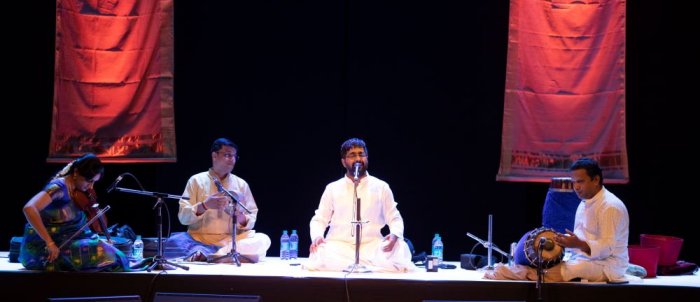 Abhishek Raghuram The sangitam of the evening continued with maestro Abhishek Raghuram, known for his assertive voice and unconventional approach to music. A grandson of Palghat Raghu, Abhishek learnt mridangam before embarking on to singing and imbibed the intricacies of rhythm, also as a khanjira artiste. He was accompanied by violinist H.M. Smitha, who equally shone with her dexterity and sensitivity. Bangalore's celebrated mridangist Arjun Kumar whose beats both anticipates the swara-s and then reverberates, was well matched by precise and powerful strokes from G. Guru Prasanna. Abhishek chose to begin with saint Tyagaraja's 'Durmaaga charaadhamulanu' in Ranjani and rupakam. The raga alapana in Madhyamavati became the highlight with the Kriti, 'Deva Sri Tapasteertha' (where Tyagaraja sings praise of Lord Shiva at Lalgudi), followed by Kalpanaswara improvisations. It seemed Tyagayya all the way, when in 'Sri Raguvara aprameya' in Kambhoji raga, the singer was in his typical exploratory mood with sudden 'breakouts' yet, detailing every aspect of the melody. The impact of his imaginative creativity was tremendous.  Rama Vaidyanathan and team On the second day, the spectators were taken into a sublime level with 'Pratibodhana' by seasoned dancer Rama Vaidyanathan and team of eight dancers. Be it the awakening from bondage in the masterpiece on Kashi, 'Vishweshwara darshan kar' in Sindhubhairavi by Swati Tirunal or the moving 'Tiruvempaavai' of Manikkavasagar, the choreography emphasized on exhaustion through harmonious clusters - 'Pindibhanda-s', unwavering nritta with a well-managed tempo that accentuated and led to the idea of deliverance. The simultaneous depiction of life and death on parallel banks of the holy Ganges was noteworthy and even simple feats like washing the feet was aesthetically conveyed. The Raasamandala motif of the ONE universe was impressive with just a Suchi hasta, donning many motifs, where the astral realm and the cycle of time (with seasons) were delineated with clarity by the team with whom Rama simply amalgamated. There was plenty of angika abhinaya with use of 'shaka' (gestures used as branches), germinating from the 'beeja' (seed or plot), with action of the arms, hands, fingers and lower limbs, in order to convey the point. The representation with sattvika or purely facial expressions, although minimal was effective in brevity. Rama succeeded to underline the Sancharibhava-s to establish the sthayi through intelligent use of tableaux and contours. The music score by the gifted musician Sudha Raghuraman brought out the abhinaya to the fore. 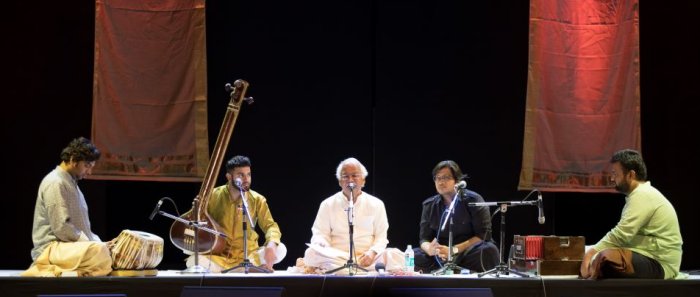 Dr. Nagraj Havaldar & team On the morning of day three of BIAF, Dr Nagraj Havaldar's lecture demonstration on Pandit Kumar gave an insight into the life of a child prodigy who made music his life. Through an intensive research, the speaker shared moments from the life of this genius that was indeed inspiring. The different stages from his life truly touched the Rasika-s and taught an important life lesson: true dedication and determination can convert dreams into reality. Dr. Havaldar's own music is known for its divinity and vast knowledge. 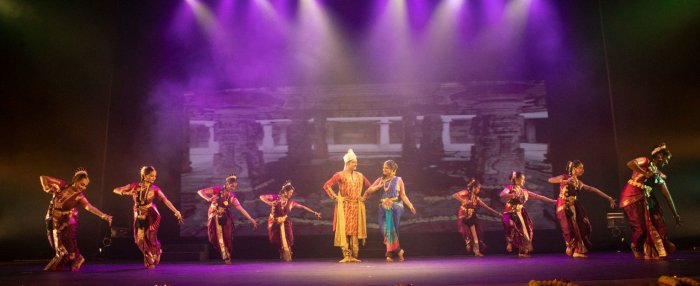 Veena Murthy Vijay's group Silappadhikaaram is an important historical and sociocultural literary work by Ilango Adigal, a Jain monk who was a Chera prince and a poet. It is a combination of the Tamil 'silambu' (anklet) and 'adhikaaram' (the relevant tale). The commentator Atiyarkkunallar describes it as an epic story told with poetry, music, and drama. This story resonates with popularity in Kerala and Dr. Veena Murthy Vijay has directed and choreographed the Malayalam version, conceptualized by Lalitha Das. The adaptation has revisited the tale with certain added aspects too. The epic deals with humanitarian concerns that are universal - the purpose of life, Karma theory, after-life or beyond death, ethical values and the principle of justice that cannot change with time. The 'drama-dance' staged as part of BIAF on day two, describes a rich and cosmopolitan culture, where people from many different sections mingle in the cities of Poompuhar and Madurai. It speaks vociferously, with audio visuals in the backdrop, about a great flowering of the arts, enjoyed by different people. The drama, like a colourful illustrative Amar Chitra Katha, was interspersed with English narratives, built to cater to mass appeal, beyond any language or regional barriers. The story in a nutshell, is how Kannagi took revenge on the King, who had wrongfully put her husband Kovalan to death. It is based upon ordinary people and their struggle. Kovalan, the son of a wealthy merchant and the husband of Kannagi, meets Madhavi in a performance in the Chola king Karikalan's court. This scene is depicted in the performance with Madhavi (an expert as per the legend in many types of dances (Koothu-s); herein replaced by varied classical dances as seen today) taking centerstage and Kovalan watching her mesmerized in the background. An emphasis on the pivotal point of the hero falling blindly in love could have perhaps been augmented by metaphoric lyrics that suggest the same. A penniless hero confesses his deceit, but Kannagi forgives him and gives him one of her anklets to sell to a merchant who falsely frames him as a thief and gets him executed. Kannagi throws the other jewelled anklet, curses the king and Madurai gets burnt. Incidentally, the history of the Kodungallur Devi temple dates back to the Chera period. It is in this temple that Kannagi is believed to have attained salvation. The performance signed off with a climax that brought Kathakali dancing to portray the rage of fury. Shama Krishna displayed strong bhavam in her role and Mithun Shyam as the hero was striking while a vivacious Sangeeta Phaneesh played Madhavi. In all, there were about 40 dancers performing Kuchipudi, Odissi, Kathak, martial arts and a generous use of aharya and vaachika abhinaya with continuous action, that were run by the tracks produced by Praveen Rao (with glimpses of contemporary score), presenting a grand spectacle. 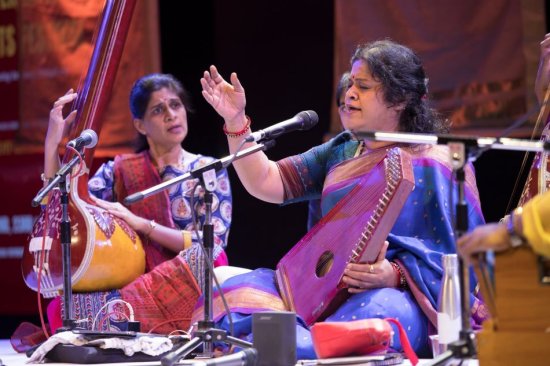 Sangeetha Katti March 25th morning also saw singer Sangeetha Katti, yet another leading Hindustani classical vocalist, who presented in raag Alhaiya Bilawal, a Khyal and two Bandishes, followed by a 'Nirgun' bhajan and a Vachana in raag Bilaskhani Todi. Her rich performing experience, known for the modulation and natural grace kept the audience totally in tune with her. The remarkable accompanists were on the tabla - Pt.Rajendra Nakod and on harmonium - Pt. Vyasmurthy Katti. 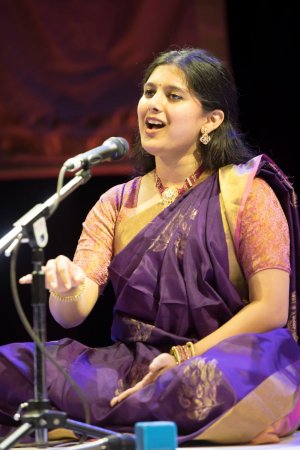 Vidula Venugopal The young and promising Vidula Venugopal, a disciple of the illustrious Pt. Dhananjay Hegde, presented two compositions in raag Nat Bhairav, both composed by Dr. Ashwini Bhide Deshpande, a Bada Khyal in the rare Vilambit Jhaptaal followed by a Chota Khyal in Dhrut Ektaal. She concluded her performance with a popular abhang of Sant Tukaram and was accompanied on the tabla by Kaushik Bhat and on the harmonium by Gaurav Gadiyar. Her bright future seems evident. 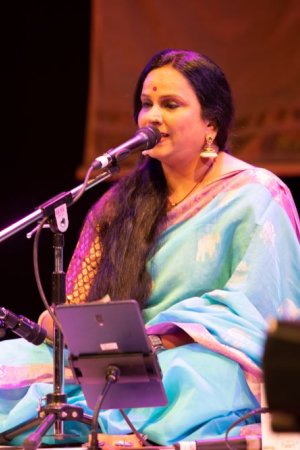 Chandana Bala Kalyan Philosophy and poetry are always together in the Bharatiya tradition and when set to divine melody, it touches the innermost recesses of hearts. 'Marma' by Chandana Bala Kalyan on day three (evening sessions) was multi-lingual, traversing through different musical poetry that are on the path to the divine. She rendered at first, akin to a Taanavarnam, a well composed Sankirtan in Shyamakalyan raga with various names of Lord Narayana. The Ugabhoga of Puranadaradasa came next with soulful rendition. The spirit of surrender or Atmanivedana with Madhura Sringara bhakti came in with the celebration of the festival of colours - Holi, that radiated in Brindavan. Chandana sang a composition from Jayadeva's Gita Govindam next, preceded by an Odia poetry on Jagannatha of Puri. It is always the virahotkhandita nayika, in agony of being separated from the Lord, who can take the shades of Kama to Prema and Nitya levels. Sant Tukaram's Abhang as a Ninda Stuti compares Panduranga with a 'bhoot' who scares people but can absorb the true devotee completely. Bhulle Shah, the Punjabi sufi poet and a Kabir doha concluded the performance that was exceptionally supported by Adarsh Shenoy on tabla and Satyajit Sanju on harmonium and keys.  Pt Venkatesh Kumar Pandit Kumar Gandharva 100th birth anniversary concluded with Pt M. Venkatesh Kumar. A robust, vibrant voice made the whole auditorium inmates, spellbound. He presented Maru Bihag, Rasiya ho na ja in Vilambit Ektaal, Mana mein raho in Drut teentaal, raag Jogkauns - Sughara Vara Paayo and Peera parayo. The old traditional Bandish in raag Kafi, Aaj khelo Shyaam sanga hori, gave a joyful invitation to play Holi that coincided with the last day of this cultural extravaganza. Panditji rendered a popular Basava vachana in Jaunpuri and a Puranadara Devarnama that spoke volumes of his virtuosity. 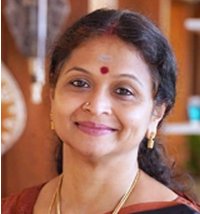 Dr.Padmaja Suresh is an acclaimed Bharatanatyam exponent and research scholar with three books to her credit, including the latest- Dance of Tantra and a Satguru. She heads the Aatmalaya academy, Bangalore. |